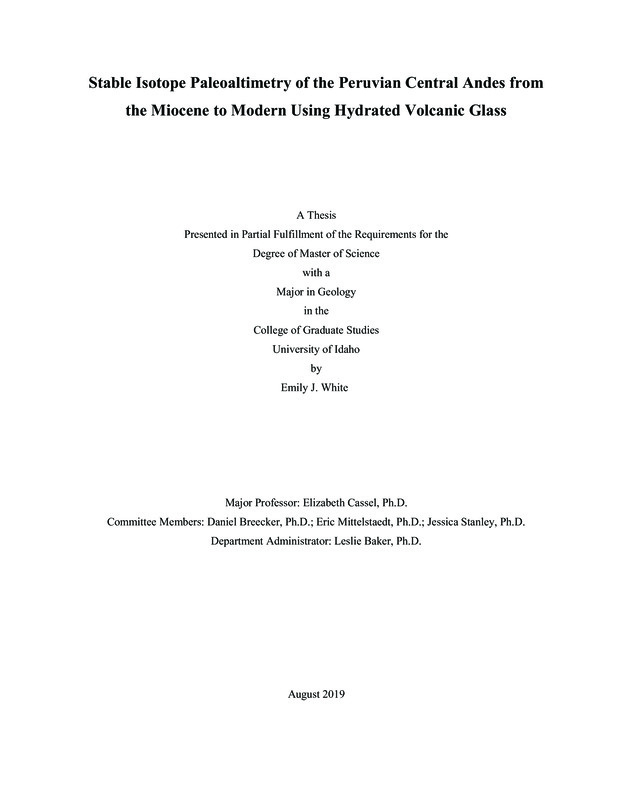Stable Isotope Paleoaltimetry of the Peruvian Central Andes from the Miocene to Modern Using Hydrated Volcanic Glass
White, Emily. (2019-08). Stable Isotope Paleoaltimetry of the Peruvian Central Andes from the Miocene to Modern Using Hydrated Volcanic Glass. Theses and Dissertations Collection, University of Idaho Library Digital Collections. https://www.lib.uidaho.edu/digital/etd/items/white_idaho_0089n_11637.html
- Title:
- Stable Isotope Paleoaltimetry of the Peruvian Central Andes from the Miocene to Modern Using Hydrated Volcanic Glass
- Author:
- White, Emily
- Date:
- 2019-08
- Embargo Remove Date:
- 2020-08-06
- Keywords:
- Hydrogen Isotopes Miocene Uplift Paleoaltimetry Peruvian Central Andes Volcanic glass
- Program:
- Geology
- Subject Category:
- Geology
- Abstract:
-
Topography is a dynamic reflection of the duration and characteristics of interdependent tectonic and climatic regimes. The growth of high elevations and high relief in large continental orogens, such as the Andes of South America and the Himalayas-Tibetan Plateau of Asia, drive substantial perturbations in global atmospheric circulation (Molnar and England, 1990) and dictate biodiversity (Raymo and Ruddiman, 1992). As a result, paleoclimate reconstructions and models of geodynamic drivers for surface uplift depend on the timing and style of the emplacement of these topographic features. The Central Andes are the type example of subduction-driven orogenesis and magmatism (Horton, 2018) and contain two parallel mountain chains, the Western and Eastern Cordillera, with mean elevations reaching 6 km. At the center of this orogen, the Altiplano-Puna plateau has a mean elevation of 4 km and covers a 600,000 km2 area (Isacks, 1988), making it the highest subduction-driven plateau in the world (Decou et al., 2011). Despite the inherent importance of this region, the timing and style of surface uplift that led to the modern topography of the Central Andes is not well understood (Allmendinger et al., 1997; Garzione et al., 2017).
Proposed models for the timing of surface uplift range from late Oligocene to late Miocene (Garzione et al., 2017). Paleotopographic studies in the Central Andes have used a wide range of different tools, including stable isotope geochemistry, river incision modeling, genetic divergence, leaf morphology, and structural analysis to identify phases of surface uplift and make predictions about geodynamic drivers for uplift (Gregory-Wodzicki, 2000; Ghosh et al., 2006; Schildgen et al., 2007; Thouret et al., 2007; Garzione et al., 2008; Picard et al., 2008; Ehlers and Poulsen, 2009; Lease and Ehlers, 2013; Saylor and Horton, 2014; Kar et al., 2016). Current uplift models for the Central Andes include gradual, rapid, and non-uniform, surface uplift. Proposed geodynamic mechanisms for Andean orogenesis include contractional deformation (Hindle et al., 2005), removal of dense lower lithosphere and or crustal flow (Mamani et al., 2010), ablative subduction or thermal weakening (Isacks, 1988; Gosh et al., 2006), magmatic additions of mantle material (Sempere et al., 2008) and lithospheric delamination (Garizone et al., 2008). Several localized studies attribute paleoisotopic shifts to orogen-wide surface uplift, but this extrapolation has produced conflicting models for the timing of Central Andean surface uplift (Garzione et al., 2008; Ehlers and Poulsen, 2009; Saylor and Horton, 2014). These models lack adequate constraints on the modern distribution of hydrogen and oxygen isotopes ratios across the orogen, which are necessary to reconstruct the specific timing and mechanisms of surface uplift. By sampling across the width of the orogen, it is possible to identify orogen-wide shifts in paleoisotopic values, which likely result from regional surface uplift or regional climatic changes.
The research presented in this thesis includes 1) a comparison of modern isotopic values of meteoric waters in soil and precipitation to hydrogen isotope values of meteoric waters extracted from volcanic glass and 2) hydrogen isotopic values of Miocene–modern volcanic glass samples across the Peruvian Central Andes to reconstruct the past distribution of isotopic values and identify regional drivers of paleoisotopic change (i.e., climate and/or surface uplift). Chapter I provides a general geologic overview of the Peruvian Central Andes with a focus on aspects that are pertinent to this study. Chapter II presents a comparison between several meteoric water proxies to quantify past elevations. Hydrogen (and oxygen, where possible) isotope values of meteoric water are compared between records that correspond to average rainfall over ca. 10,000 years (hydrated volcanic glass), ca. 5–10 years (soil water), and 2 years (precipitation). This modern isotopic dataset spans the width of the orogen, from the Pacific coast to the Amazon Basin. Comparison of these proxies enables reconstruction of how short- and long-term isotopic records change with respect to climatic variability and through time. Chapter III provides an assessment of the spatial distribution of past surface topography through time by directly comparing modern and ancient hydrogen isotope ratios of hydrated volcanic glasses in the Central Andes. This study provides new constraints on the timing of Peruvian Central Andean surface uplift.
- Description:
- masters, M.S., Geology -- University of Idaho - College of Graduate Studies, 2019-08
- Major Professor:
- Cassel, Elizabeth J
- Committee:
- Stanley, Jessica R; Mittelstaedt, Eric L; Breecker, Daniel O
- Defense Date:
- 2019-08
- Identifier:
- White_idaho_0089N_11637
- Type:
- Text
- Format Original:
- Format:
- application/pdf
- Rights:
- In Copyright - Educational Use Permitted. For more information, please contact University of Idaho Library Special Collections and Archives Department at libspec@uidaho.edu.
- Standardized Rights:
- http://rightsstatements.org/vocab/InC-EDU/1.0/

